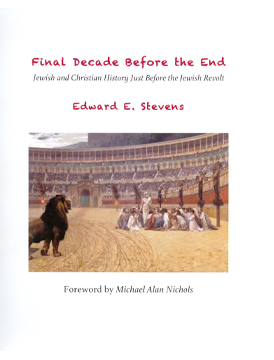One Column Page
and responsive to boot
Titus Laid Siege to Jerusalem
by Edward E. Stevens
This article appeared in the 2023 Summer issue of Fulfilled! Magazine

In our previous article we ended with Titus leaving Alexandria and marching his soldiers to Judea where they would be assembled with other troops to attack Jerusalem.
Titus Gathered His Army at Jerusalem
Josephus informs us that in the Spring of AD 70, shortly before Passover, Titus brought to the outskirts of Jerusalem a fighting force of almost 80,000 (four legions plus other auxiliaries and mercenaries), and immediately put them to work setting up their three fortified encampments, plus preparing their siegeworks (towers, ramps, battering rams, and siege engines) [Wars 5.71 (5.2.4)].
Then came Passover (Apr 70). And since Titus was not yet ready to begin the siege, he allowed Jewish pilgrims to enter the city to observe the Passover, because he knew food supplies in the city were not adequate for a lengthy siege, and that allowing more people into the city would only worsen that situation to his advantage.
However, even though Jewish pilgrims were allowed to enter the city and worship at the temple during Passover, they were not allowed to leave afterwards, but instead forced by the Zealot rebels to stay and support the war effort. This made their situation in Jerusalem increasingly intolerable and unbearable.
Three Factions Reduced to Two
Because the pilgrims were allowed in the temple compound during Passover, John of Gischala (one of the three faction leaders) took advantage of that by mingling his soldiers among the pilgrims who entered. Once inside, they tossed aside their robes, unsheathed their swords, overpowered Eleazar’s forces, and took control of the Temple complex.
This prompted Eleazar and some of his soldiers to “flee away into the subterranean caverns of the temple” [Wars 5.102 (5.3.1)] where they could escape through the tunnels to get out of the city. Yosippon claims that “Eleazar escaped from Jerusalem during the fighting and went to Masada, [where] many of the Jews gathered around him” [Sepher Yosippon, ch. 89]. Thus, both Yosippon (chs. 82, 89) and Hegesippus (5.53) place Eleazar b. Ananias in Masada after this.
The remainder of Eleazar’s men merged with John’s forces, so that the three Zealot factions were now reduced to only two (Simon b. Giora versus John of Gischala) [Wars 5.99-105 (5.3.1) and Wars 5.248-257 (5.6.1)].
Two Eleazars or Only One?
According to Josephus, there were two different Eleazars who successively controlled the temple: (1) Eleazar b. Ananias who initially took control of the temple at the beginning of the rebellion (May 66), and (2) another Eleazar b. Simon who was given control at the war council (Nov-Dec 66). However, the concept of two different Eleazars seems tenuous.
For instance, when we look at Hegesippus and Yosippon, we see that it was Eleazar b. Ananias who maintained control of the temple all the way through the war down to this time just before Titus began his siege (Heg. 5:5). Likewise, Gary J. Goldberg, curator for the Josephus.org website, suggests that “It may be that Eleazar son of Simon is the same man as Eleazar son of Ananius” [https://www.josephus.org/FlJosephus2/warChronology6Factions.htm].
Furthermore, this story in Hegesippus is supported by an inscription on a piece of pottery found on top of Masada, which reads, “[belonging to] Aqaviah son of Ananias High Priest” (mentioned in VanderKam, From Joshua to Caiaphas: High Priests after the Exile, pp. 460-463, where he cites Yadin and Naveh’s book, The Aramaic and Hebrew Ostraca and Jar Inscriptions, p. 37, plate 30). The owner of this pottery vessel was a son of Ananias b. Nedebaeus, and brother of Eleazar b. Ananias. This implies that some of Eleazar’s family were on Masada at the time it was destroyed by the Romans in AD 73.
Moreover, Carsten Thiede mentions three legal documents (promissory note, marriage contract, and divorce certificate) found at Murabba’at Cave 4 which dated before the Fall of Masada (AD 56, 64, and 71 respectively). All three were in Aramaic. The certificate of divorce, internally dated AD 71, was created at Masada and witnessed by three individuals resident there: Eliezer son of Malka, Joseph son of Malka, and Eleazar son of Hanana [Ananias]. Note that third witness. If that was the infamous Eleazar b. Ananias, then the mystery about him is resolved. [Carsten Peter Thiede, The Dead Sea Scrolls and the Jewish Origins of Christianity, pp. 66-67.]
Titus Began the Siege
As soon as the city was filled with Passover pilgrims, Titus raised the siege, thus cutting off all food supply lines from outside (May 10, 70) [Wars 5.302 (5.7.2)]. Then the battering rams and stone-throwers (ballistae) began pounding the walls [Wars 5.276-280 (5.6.4)].
Josephus records: “Now the stones that were cast were of the weight of a talent” [Wars 5.6.3 (5.270-272)]. Note the similarity to the hailstones mentioned in Revelation 16:21, “. . . huge hailstones the weight of a talent came down from heaven upon men, and men blasphemed God . . . because its plague was extremely severe.”
Josephus inadvertently shows how they blasphemed God when he says: “the watchmen that sat upon the towers gave them notice when the engine was let go, and the stone came from it, and cried out aloud, ‘The Son Cometh’” [Wars 5.270-272 (5.6.3)].
The word for “son” (ben) in Aramaic sounds similar to the word for “stone” (eben). Thus, it was a play on words. In a footnote, William Whiston suggests that this signal ‘The Son Cometh’ might have been “by way of derision [mocking, scoffing] of Christ’s threatening so often that he would come at the head of the Roman army for their destruction” [Wars 5.272 (5.6.3) footnote].
Plagues and Severe Famine
Right after Passover (May 70) the city of Jerusalem suffered a very destructive pestilence (plague) and severe famine [Wars 6:421 (6.9.3)]. This was predicted by Jesus and the Apostles (Matt 24:7; Mark 13:8; Luke 21:11; Rev 2:23; 6:8; 9:18, 20; 11:6; 15:1, 6, 8; 16:9, 21; 18:4, 8; 21:9; 22:18).
Because food was scarce, the Zealot soldiers daily terrorized the citizens to obtain whatever bits of food they could find [Wars 5.24-25 (5.1.4) and 5.427 (5.10.2)]. Their sexual perversion, profanity, tyrannical and abominable conduct earned the condemnation of Josephus and the wrath of God [Wars 4.556-563 (4.9.10); Wars 5.411-414 (5.9.4); Wars 5.442-445 (5.10.5)]. They were forced to eat shoe leather, the leather off their shields, old wisps of hay, and even dung. After one mother killed her nursing infant and ate it, the city was filled with cannibalism [Wars 6.197-208 (6.3.3-4); Wars 5.571 (5.13.7); Antiq. 18.8 (18.1.1); Wars 6.421 (6.9.3); and Wars 6.197-208 (6.3.3-4). This same kind of tribulation occurred during the siege of Nebuchadnezzar in 586 BC, which was likewise predicted by Moses in Deuteronomy 28:53ff (cf. Lam 2:20; 4:10; Lev 26:29; 2 Kings 25:1-3).
From that point onward the affairs of the Jews rapidly deteriorated:
- The outer wall (the third wall) was breached by the Romans (May 7, 70).
- The second wall was opened temporarily on May 12th, then permanently in June.
- The Tower of Antonia was captured (Jul 5, 70).
- The perpetual Daily Sacrifice (the Tamid) ceased (late July or early August) because of a lack of priests [Wars 6.93-110 (6.2.1)].
- The northwest portico of the Temple was burned (Jul 24, 70) in order to sever the connection with the Tower of Antonia.
- The Temple was burned on the tenth day of Lous (Av) (Aug 10, 70), the same date as the first destruction by the Babylonians [Wars 6.249-268 (6.4.5-8)]. Six thousand women and children went up on the Temple cloisters that day hoping to see deliverance, but every one of them perished, either in the flames or by throwing themselves down headlong upon the pavement below. “A false prophet was the occasion of these people’s destruction” [Wars 6.285-288 (6.5.2-3)].
- Siege of the Upper City Began (Aug 20, 70), and the wall was breached on Sept 7, 70 [Wars 6.392 (6.8.4) and Wars 6.401-408 (6.8.5)].
- Jerusalem was now under the control of the Romans [Wars 6.407 (6.8.5) and 6.435 (6.10.1)]. Both of the remaining Zealot leaders, Simon b. Giora and John of Gischala, came out of their underground hiding places and surrendered to the Romans. Titus took them to Rome to be used in the Triumphal celebration. Simon was killed at the end of the Triumph, and John was held in chains for the rest of his life [Wars 6.433-434 (6.9.4)].
- Now only three fortresses remained in the hands of the Zealots (Machaerus, Herodium, and Masada). We will pick up our narrative at this point next time.
For greater detail on the identity of Eleazar, email me with your request for my article and chart (Eleazar_Chart.jpg) which shows how Josephus, Yosippon, Hegesippus, and Tacitus dealt with Eleazar b. Ananias in their historical accounts. Also be sure to check out our historical podcasts (www.buzzsprout.com/11633), and get a copy of my historical work, Final Decade Before the End, at our webstore: www.preterist.org/product-cat/all/
Comments:
Your honest review will help others in their search for truth. If you must leave a negative review please be gracious.
Rather, speaking the truth in love, we are to grow up in every way into him who the head, into Christ . . . .
(Ephesians 4:15)
We use "Disqus" commenting software. If you are not familiar with "Disqus," click here for more information. You don't need a Disqus account to post comments, however, without an account you won't be notified if someone responds to your post.
 Fulfilled
Fulfilled